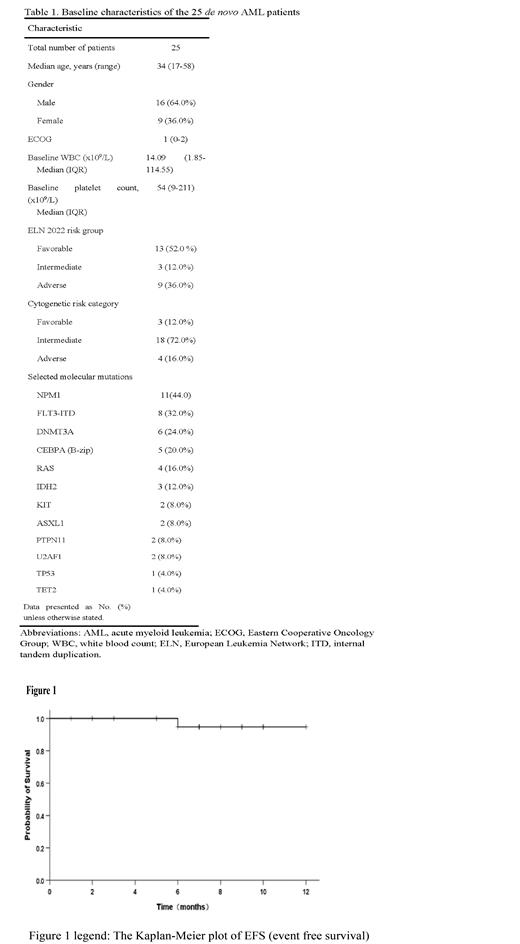INTRODUCTION
Venetoclax (Ven), a potent oral inhibitor of BCL-2, has improved clinical outcomes in acute myeloid leukemia. For chemotherapy-fit patients, Ven combined with intensive chemotherapy (IA, CLIA, FLAG-IDA and DA) achieves high complete response (CR) rate and measurable residual disease (MRD)-negative rates in de novo AML after one cycle of induction therapy. Homoharringtonine (HHT, omacetaxine mepesuccinate) is an alkaloid derived from trees of the genus Cephalotaxus. HHT, cytarabine (Ara-C) and daunorubicin (DNR) regimen (HAD) have been used as standard remission induction regimen in China.
Here, we reported the data of 25 patients with newly diagnosed AML who were administered with Venetoclax combining with dose-reduced HAD as induction treatment in our hospital. The purpose of this study was to observe the efficacy and safety of the regimen.
METHODS
Between May 2022 and February 2023, twenty-five newly diagnosed AML who fulfilled the criteria of AML according to the 2016 World Health Organization (WHO) classification were treated with Ven combined with HAD as induction treatment.
The induction regimen consisted of oral Ven (100mg Day -1; 200mg Day 0; 400 mg, Days 1-7), intravenous HHT (2mg/m 2/d, Days 2-6), DNR (45 mg/m²/d, Days 4-5), and Ara-c (100 mg/m 2/d, Days 2-6). After achieving CR, allogeneic hematopoietic stem-cell transplantation (allo-HSCT) were recommended according to ELN guidelines. Patients who could not or did not need allo-HSCT received consolidation ± maintenance therapy. The consolidation therapy included two cycles of Ven combining with intermediate-dose Ara-C (Ven 400 mg on Days 1-7, Ara-C 1 g/m 2/q12 h Days 2-4), two cycles dose-reduced DA (DNR 45 mg/m², Days 1-2 and Ara-C 100 mg/m², Days 1-5) chemotherapy and one cycle HA (HHT 2 mg/m², Days 1-5 and Ara-C 100 mg/m², Days 1-5). After completing consolidation treatment, patients (intermediate and adverse risk) entered maintenance therapy with AZA (100 mg/d, Days 1-5) every month for at least four cycles.
The primary endpoints were the overall response rate (ORR), included of complete remission (CR), complete remission with incomplete blood cell count recovery (CRi), and partial response (PR). Secondary endpoints were overall survival (OS), event-free survival (EFS), disease-free survival (DFS), and the safety of regimens.
RESULTS
Between May 2022 and February 2023, 25 patients who were enrolled in this study. Baseline characteristics of the twenty-five patients are shown in Table 1.
After one cycle of induction therapy, twenty-one patients achieved CR, CR rate was 84.0% (21/25 95% CI, 68.6-99.4); one patient achieved PR. The ORR (CR+PR) was 88.0% (22/25 patients; 95% CI, 74.3-100). Three NR patients and one PR patient achieved remission after salvage therapy. For patients who achieved CR after one cycle of induction therapy, MRD was evaluated in 21 patients by flow cytometry and 17 patients attained MRD negative (81.0%; 95% CI, 61.6-96.7). None patient died before response evaluation .
To June 20, 2023, with a median follow-up of 10.0 (4-13) months, 9 (36.0%) patients underwent allo-HSCT. The median OS, EFS, and DFS were not reached, and the estimated 1-year OS, EFS, and DFS rates were 100%, 94.7% (95% CI, 89.6-99.8%), and 94.7% (95% CI, 89.6-99.8%), respectively (Figure 1).
The most frequent hematological adverse events were Grade 3 to 4 anemia, thrombocytopenia, and neutropenia during the induction treatment and occurred in all patients (25/25 100%). The most frequent grades 3-4 non-hematological adverse events were febrile neutropenia (25/25 patients, 100%). None of patients died during the induction therapy.
Conclusion: Ven combined with HAD is an effective and safe induction regimen in de novo AML patients. It is worth and necessary to enroll more patients to further verify this regimen.
【Keywords】Venetoclax; HAD; AML; induction treatment
Disclosures
No relevant conflicts of interest to declare.


This feature is available to Subscribers Only
Sign In or Create an Account Close Modal